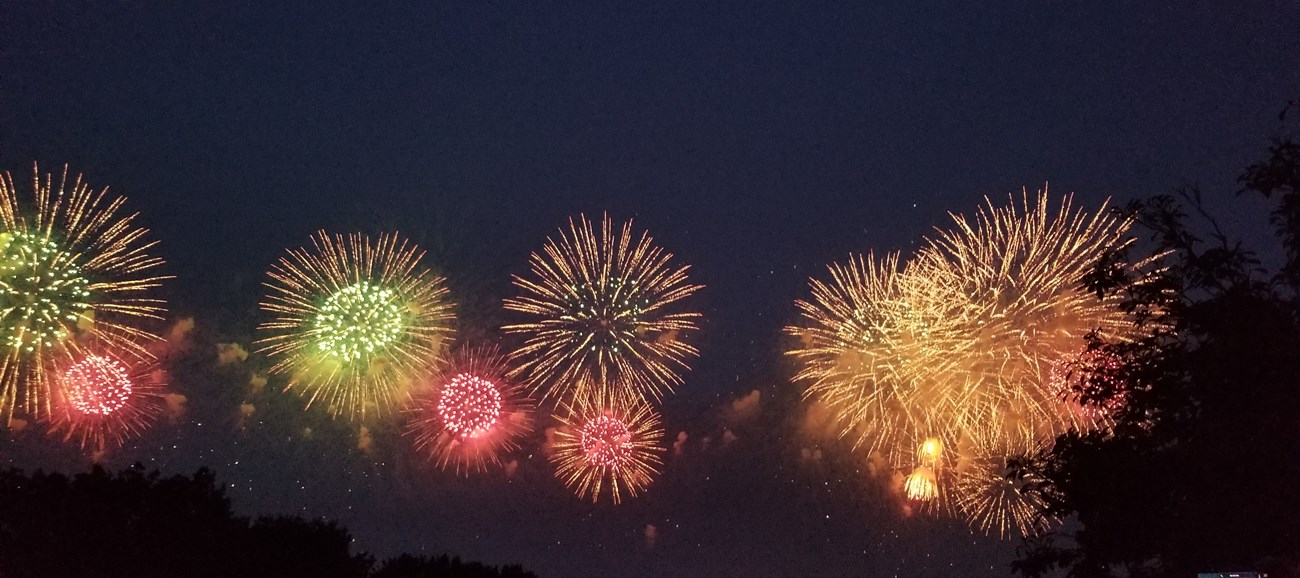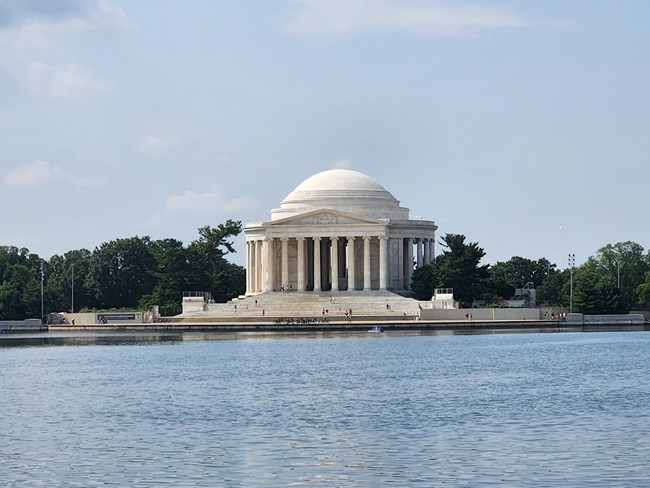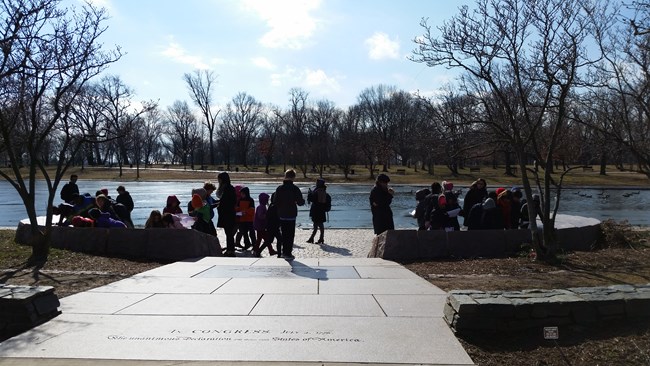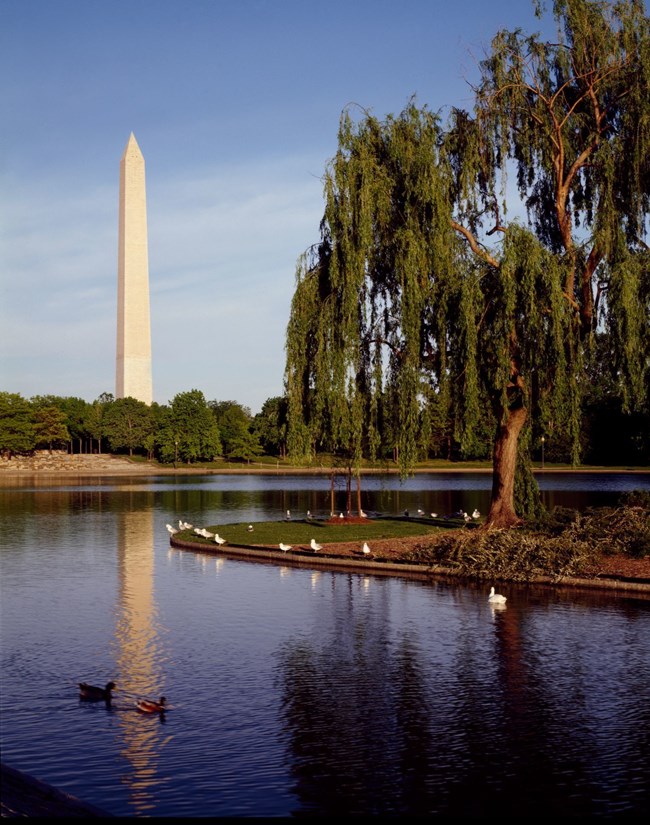Last updated: July 7, 2023
Article
NAMA Notebook: Summer!

J. Rudnick/NPS
Happy Summer!
We hope that teachers are relaxing and rejuvenating for the new school year. For NAMA staff, the start of summer means preparing for the park’s busiest day, the Fourth of July. The Independence Day celebration brings thousands of people out to the park. People stake out a spot early in the day with their blankets and picnic baskets to take part in the nation’s birthday party. Sometimes park rangers find that visitors to the National Mall are not very interested in learning about the significance of this historic day; they are often focused on enjoying the holiday with friends and family as they look forward to the fireworks. We understand. But the park does have a number of resources to encourage further study of the nation’s founding that might be helpful to teachers throughout the year.

J. Rudnick/NPS
Thomas Jefferson Memorial
Since July 4th is all about the adoption of the Declaration of Independence, a good place to start on the National Mall is the Thomas Jefferson Memorial. Opened on April 13, 1943 on Thomas Jefferson’s 200th birthday, the memorial includes words written by Jefferson on a variety of occasions, including an excerpt from the Declaration. Writing the Declaration was one of the three accomplishments Jefferson wanted to be remembered for, along with writing Virginia’s Statute for Religious Freedom and founding the University of Virginia. Jefferson’s words explained why the colonies wanted to separate from Great Britain and served as the basis for the new nation. He wrote that “all men are created equal,” though his meaning of that statement and today’s meaning are different. Students are quick to point out when touring the memorial that Jefferson didn’t include women or people of color.
The question of whether Jefferson deserves a memorial can be a fascinating debate. How do we reconcile his declaration that "all men are created equal" with the fact that he enslaved hundreds of people? His words were aspirational for the new nation, but not something he put into practice personally. As we see on the National Mall, leaders who came after Jefferson often quoted him in sharing their messages. Abraham Lincoln referenced the Declaration of Independence in the Gettysburg Address in 1863. One hundred years later, Dr. King quoted Jefferson in his ”I Have a Dream” speech. Those leaders worked to make Jefferson’s words more inclusive of the whole population.
To learn more about Jefferson’s words found in the inscriptions at the Thomas Jefferson Memorial, explore the online education series: Quoting Out of Context? Learn about how the inscriptions were chosen and evaulate whether Jefferson's views are properly represented in the memorial.

J. Rudnick/NPS
Constitution Gardens
A lesser-known site on the National Mall that ties into the story of Independence Day is the Memorial to the 56 Signers of the Declaration of Independence, located in the area of the park known as Constitution Gardens. The Signers Memorial was built in 1984 with funding left over from the Bicentennial, when Constitution Gardens was created. Once the site of temporary government office buildings, Constitution Gardens was meant to be a quiet natural setting for those wanting to escape the bustling city nearby. Visitors cross a wooden bridge to reach the Signers Memorial, which is on an island in the man-made pond that is the center of Constitution Gardens. The memorial is arranged by colony and each signer of the Declaration has a stone with his name, signature, and occupation engraved.

J. Rudnick/NPS
One of our rangers created an activity to encourage young visitors to explore the memorial. Here are some questions you can use with your students, either while visiting the memorial or in the classroom:
- How many men signed the Declaration of Independence?
- Who had the largest signature?
- Which colony had the most signers?
- Which two signers from Virginia had the same last name? Can you find another state with two related signers?
- Which signer has his own memorial on the Tidal Basin?
Constitution Gardens and the 56 Signers Memorial are often a surprise for students and teachers. They can provide a momentary escape from the more crowded sites on the National Mall. There’s also a good chance of a wildlife sighting, from ducks and geese to a great blue heron.

Carol M. Highsmith's America, Library of Congress, Prints and Photographs Division
Washington Monument
While standing on the island or almost anywhere else in the park, one can see the Washington Monument, built to honor George Washington, particularly for his role as general in winning the war for American independence. Washington’s towering monument represents his leadership and serves as a starting point to explore the Revolutionary War, George Washington, and his legacy. Especially as we approach 2026 and the 250th anniversary of American independence, Washington’s Monument and legacy will be a big part of the National Mall story.
If you have ideas for how to mark the 250th of the Declaration of Independence, let us know! Contact Us
More Resources
Teaching with Historic Places lesson plan The Washington Monument:Tribute in Stone
For a fun activity exploring the story of how the Washington Monument was built Build Your Own Adventure: Washington Monument
